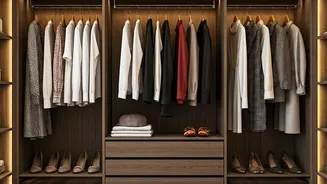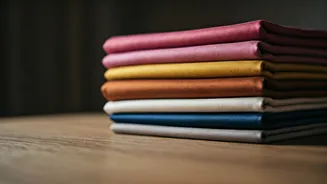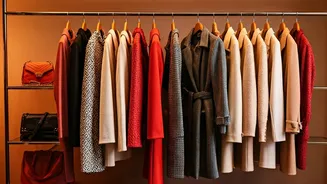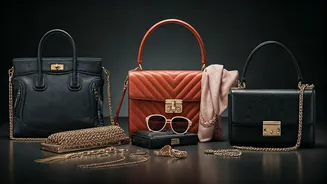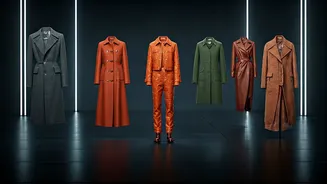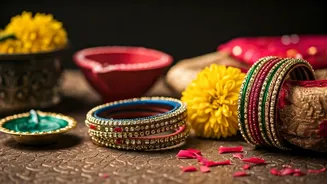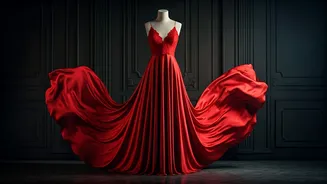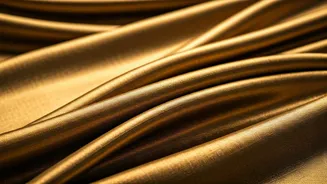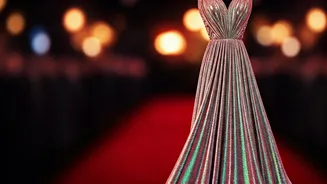Define Your Style
Understanding your personal style is the foundation of a great wardrobe. Begin by assessing what you already have and what you genuinely enjoy wearing.
Consider the activities you participate in regularly and the image you want to project. Are you drawn to classic, minimalist, bohemian, or edgy looks? Explore different fashion aesthetics through magazines, websites, or social media. Identify recurring themes in the outfits you admire, such as specific silhouettes, color palettes, or textures. This initial step will help you make informed decisions when shopping for new items and prevent impulse purchases that don't align with your overall style. Knowing your style helps you avoid wasting money on clothes that do not fit. By gaining an understanding of your preferences, you will eventually be able to narrow down which outfits suit your taste and become much easier to make choices.
Essential Wardrobe Pieces
Building a versatile wardrobe requires a collection of key pieces that can be mixed and matched. Start with foundational items like a well-fitting pair of jeans, a crisp white shirt, a classic black blazer, and a versatile dress (such as a little black dress). Include neutral-colored tops, such as t-shirts and blouses, that can be paired with various bottoms. Invest in a couple of versatile bottoms, such as a tailored skirt or pants. Consider adding a tailored coat for layering during cooler months. These core pieces will serve as the building blocks for numerous outfits, allowing you to create different looks based on the occasion. Focusing on classic, high-quality items will ensure that your wardrobe remains timeless and adaptable to changing trends, helping you to effortlessly transition from casual to more formal events.
Color Coordination Secrets
Mastering color coordination is essential for creating visually appealing outfits. Understanding color theory can significantly enhance your ability to mix and match colors. Learn about complementary colors (colors opposite each other on the color wheel), analogous colors (colors next to each other), and neutral colors (such as black, white, and gray). Using a color wheel can help you to choose combinations that will make your outfit stand out. Start by incorporating a few neutral colors in your outfit. Experiment with incorporating a pop of color through accessories. Building your confidence with color combinations requires practice. Start with monochromatic looks and gradually add more colors to create a look that showcases your personality. Keep the occasion in mind. You may want to use brighter colors in a casual setting. When going to a professional setting, stick to a more neutral and subtle color palette.
Texture and Pattern Play
Adding texture and patterns can elevate your outfits by adding depth and interest. Incorporate different textures, such as knitwear, leather, denim, and silk, to create a layered look. When combining patterns, consider their scale and how they complement each other. Pair a bold print with a more subdued pattern or a solid color to balance the outfit. Mixing textures and patterns can add depth and make the outfit more interesting. A printed scarf can enhance a simple outfit. A textured bag or shoes can add interest to an otherwise simple look. Experiment with different textures and patterns to find combinations that suit your style. To make the most out of this process, start with subtle combinations and gradually build up your way to more advanced ones.
Accessorizing Effectively
Accessories can transform an outfit, providing the finishing touch. Choose accessories that complement your outfit, and consider the overall style you want to achieve. A statement necklace can instantly elevate a simple top, while a scarf can add warmth and style. Belts can define your waist and add structure to your look. Hats, gloves, and scarves can add a practical touch and style, especially during colder months. Select accessories that reflect your personal style. It is important to remember the occasion. A simple and elegant necklace works well in an office setting. Consider your personality, too. The right accessories will enhance your outfit and make you feel more confident. Accessories offer a wide range of opportunities for customization, so have fun with them!
Fit and Silhouette
The fit of your clothes significantly impacts your overall appearance. Understand your body shape and select garments that flatter your figure. Consider the silhouette you want to achieve. Experiment with different styles, such as A-line, fitted, or oversized. Tailor your clothes to achieve a perfect fit. A well-fitting garment enhances your look and boosts your confidence. The way clothes fit can make a big difference in how an outfit looks. Learn about different silhouettes to create the look you desire. If you aren't familiar with what styles suit your body, consider getting help from a stylist. Experiment with different shapes, like the classic A-line dresses, fitted tops, or oversized jackets. Remember, the best fit is a combination of comfort and style, making you feel your best.
Building a Capsule Wardrobe
A capsule wardrobe consists of a carefully curated collection of versatile pieces that can be mixed and matched to create numerous outfits. Begin by selecting a base color palette, then add complementary items to suit your style. Each piece should coordinate with many items in your closet. Avoid buying items that you can't combine with other things you own. By prioritizing quality over quantity, you can build a stylish and functional wardrobe. A capsule wardrobe will also simplify your shopping process and help you avoid impulse purchases. Regularly assess your wardrobe and eliminate items that no longer fit or suit your lifestyle. This minimalist approach to dressing can significantly improve your style and streamline your daily routine. It is important to choose pieces that are timeless, easy to wear, and reflect your unique style, creating a foundation for effortless fashion.
Seasonal Wardrobe Transitions
Adapt your wardrobe to the changing seasons by making smart transitions. As the seasons change, you'll want to adapt your clothing choices. Consider storing away items that do not fit the weather. In spring, lighten up your color palette and add lighter layers, such as cardigans and jackets. In summer, incorporate breezy fabrics, like linen, and wear lighter colors. Transition to fall by layering with sweaters and jackets. In winter, use warmer, heavier fabrics, such as wool and cashmere. Always make sure that you are prepared for changes in weather. Update your accessories to complement each season. This method ensures that your style remains current and practical. Review your wardrobe at the start of each season. Consider adding seasonal pieces like boots, scarves, or gloves. This keeps you stylish year-round.
Personal Style Evolution
Your personal style will evolve over time as you learn and grow. As you gain more confidence and experience with your wardrobe, you'll become more willing to experiment. Explore new trends while staying true to your style. As you gain a better understanding of your preferences, you'll be able to curate a wardrobe that reflects your individuality. It is important to remember that trends are temporary. They should be adapted to suit your taste. Embrace this evolution and do not hesitate to try new things. If you find a new style that resonates with you, do not hesitate to incorporate it into your wardrobe. Keep what works, discard what doesn't. Your style is an ongoing process, so learn to enjoy it!
Shopping Smartly
Shopping is a critical part of building and maintaining a stylish wardrobe. Do your research before buying new clothes. Take your time to discover sales and discounts. If possible, stay away from impulse purchases. Buying from online stores is fine, but make sure to read reviews before buying. Invest in quality items. Take care of your clothes to make them last longer. By following these tips, you will eventually be able to build a versatile wardrobe that suits your style and your budget. Consider buying sustainable and ethical clothing options. Buying clothes made from better quality materials will also ensure that they last longer, and help create a positive impact on the environment. Always purchase items that you genuinely love and can see yourself wearing for a long time. By buying the right clothes, you will also be able to create a positive impact on your own fashion sense!
